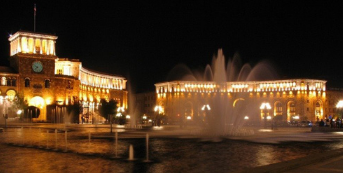 Yerevan is the capital and largest city of Armenia and one of the world’s oldest continuously inhabited cities. Situated along the Hrazdan River, Yerevan is the administrative, cultural, and industrial center of the country. It has been the capital since 1918, the thirteenth in the history of Armenia. The total area of the 12 districts of Yerevan is 227 square kilometres (88 square miles).
Yerevan is the capital and largest city of Armenia and one of the world’s oldest continuously inhabited cities. Situated along the Hrazdan River, Yerevan is the administrative, cultural, and industrial center of the country. It has been the capital since 1918, the thirteenth in the history of Armenia. The total area of the 12 districts of Yerevan is 227 square kilometres (88 square miles).
Economy
Yerevan’s manufactures include chemicals, primary metals, machinery, rubber products, plastics, textiles, alcoholic beverages and processed food. Armenian beverages, especially the Armenian cognac and beer have a worldwide fame. Hence, Yerevan is home to many leading enterprises of Armenia and the Caucasus for the production of alcoholic beverages, such as Yerevan Brandy Company, Yerevan Ararat Wine Factory, Yerevan Kilikia Beer Company and Yerevan Champagne Wines Factory. The carpet industry in Armenia has an ancient tradition and a deeply-rooted history, therefore, the carpet production is rather developed in Yerevan with three major factories that also produce hand-made rugs. Nowadays, the main branch of the Armenia’s economic development is the sphere of Information Technologies. In the early 2000s a great number of foreign companies set up their programming offices in Armenia, the main reason of which were highly qualified specialists. Now Synopsys is the largest software company in Armenia, where more than 500 specialists are working.
Culture
Yerevan is home to dozens of museums, art galleries, and libraries. The most prominent of these are the National Gallery of Armenia, the History Museum of Armenia, the Cafesjian Museum of Art, the Matenadaran library of ancient manuscripts, and the Armenian Genocide museum. Others include the Modern Art Museum, the Children’s Picture Gallery, and the Martiros Saryan Museum. Moreover, many private galleries are in operation, with many more opening every year, featuring rotating exhibitions and sales.
The city is home to many cinema halls; among them the famous Moscow Cinema. Most of the world’s hit movies are available to watch there. Since 2004, every year Moscow Cinema hosts the Golden Apricot international film festival. Many other cinema halls characterized with important architectural values are operating in the city such as Hayrenik Cinema, Nairi Cinema, Rossiya Cinema, etc.
The Yerevan Opera and Ballet Theatre consists of two concert halls: Aram Khatchaturian concert hall and the hall of the National Theatre of Opera and Ballet named after Alexander Spendiarian. The Komitas Chamber Music Hall is the home of chamber music in Armenia.
Education
Yerevan is a major educational centre in the region. It has 166 nursery schools, 259 public education schools, 12 state schools for music and art with many other state-owned schools for special needs.
Currently, 90 institutes of high education are operating in the Republic of Armenia. As a capital city, Yerevan has the majority with 71 institutions, of which 19 are state universities and the rest 52 are private ones. Around 100 thousand students are studying in the universities of Yerevan.
The most prominent universities of Yerevan include: Yerevan State University (YSU, 1919), Yerevan State Musical Conservatory named after Komitas (YSC, 1921), Armenian State Pedagogical University named after Khachatur Abovian (ASPU, 1922), Yerevan State Medical University named after Mkhitar Heratsi (YSMU, 1930), State Engineering University of Armenia (SEUA, 1933), Yerevan State Linguistic University named after Valery Brusov (YSLU, 1935), Armenian State University of Economics (ASUE, 1975), Yerevan State University of Architecture and Construction (YSUAC, 1989),American University of Armenia (AUA, 1991), Fondation Université Française en Arménie (UFAR, 1995) and Russian-Armenian State University (RAU, 1997).
Sights of Yerevan
Yerevan is rich in masterpieces of the national architecture. Particularly, State Academic Theatre of Opera and Ballet, Matenadaran, Concert and Sport Complex, Haghtanak and Kievyan bridges are distinguished. On the Tzitzernakaberd hill, rises memorial complex dedicated to the memory of Armenian Genocide victims and in the park Haghtanak – monument “Mayr Hayastan”.
Matenadaran
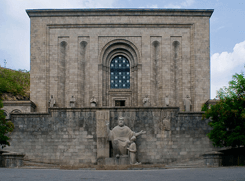 On the northern part of Mashtots avenue there is Matenadaran (a book depository), one of the world’s most ancient libraries. Its collections comprise ancient Armenian books and miniature paintings that have gained worldwide fame. Among its unique treasures are the works of ancient classical authors and rare manuscripts that have come to our days only in the Armenian translation. Several monuments to the outstanding Armenian cultural are located in the courtyard of Matenadaran.
On the northern part of Mashtots avenue there is Matenadaran (a book depository), one of the world’s most ancient libraries. Its collections comprise ancient Armenian books and miniature paintings that have gained worldwide fame. Among its unique treasures are the works of ancient classical authors and rare manuscripts that have come to our days only in the Armenian translation. Several monuments to the outstanding Armenian cultural are located in the courtyard of Matenadaran.
Republic Square
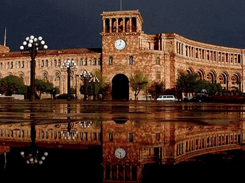 Republic Square is the main square of Yerevan and is situated in the heart of the town. This architectural ensemble was designed in 1926 by Alexander Tamanyan and includes the following constructions
Republic Square is the main square of Yerevan and is situated in the heart of the town. This architectural ensemble was designed in 1926 by Alexander Tamanyan and includes the following constructions
The History Museum
Building of the government of the Republic of Armenia
The Central Post Office
“Armenia Marriott” Hotel
The building of Ministry of Foreign Affairs
The oval part of the Square is decorated with beautiful mosaic. In front of the History Museum raise famous “singing fountains”.
National Academic Opera and Ballet Theatre
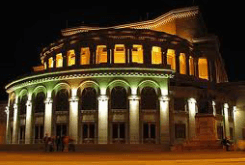 The National Academic Opera and Ballet Theatre was founded in 1932. The first opera performed in National Academic Theatre was “Almast” by A. Spendiaryan. In 1939 the theatre was named after Spendiaryan. The building has two main halls: Aram Khachaturian Concert Hall and the National Academic Opera and Ballet Theatre.
The National Academic Opera and Ballet Theatre was founded in 1932. The first opera performed in National Academic Theatre was “Almast” by A. Spendiaryan. In 1939 the theatre was named after Spendiaryan. The building has two main halls: Aram Khachaturian Concert Hall and the National Academic Opera and Ballet Theatre.
Cascade
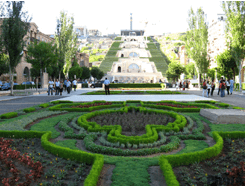 Right behind the statue of Alexander Tamanyan, the architect of the central Yerevan, is the famous Cascades. This massive staircase that connects central Yerevan to the Victory Park is scented by flowers growing on multiple levels. Each level of Cascades presents statues from world known sculptors such as Lynn Chadwick and Fernando Botero, cross stones and a wider scene of the city.
Right behind the statue of Alexander Tamanyan, the architect of the central Yerevan, is the famous Cascades. This massive staircase that connects central Yerevan to the Victory Park is scented by flowers growing on multiple levels. Each level of Cascades presents statues from world known sculptors such as Lynn Chadwick and Fernando Botero, cross stones and a wider scene of the city.
Erebouni fortress
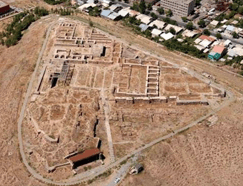 The fortress of Erebuni is on Arin-Berd hill. The Urartian king Argishti the first built it in 782 B.C. During the excavations started in the 19th century a cuneiform inscription was found, according to which the history of nowadays Yerevan starts from this place. On the top of the hill, the ruins of the citadel and the frescoes on the wall reveal the high artistic achievements of those remote centuries. The museum down the hill displays the finds that have been excavated in the territory of the fortress.
The fortress of Erebuni is on Arin-Berd hill. The Urartian king Argishti the first built it in 782 B.C. During the excavations started in the 19th century a cuneiform inscription was found, according to which the history of nowadays Yerevan starts from this place. On the top of the hill, the ruins of the citadel and the frescoes on the wall reveal the high artistic achievements of those remote centuries. The museum down the hill displays the finds that have been excavated in the territory of the fortress.
Tsitsernakaberd
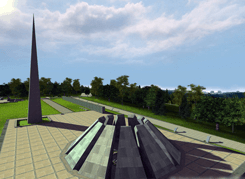 The memorial-complex to the victims of the Armenian genocide in 1915 towers over Tsitsernakaberd hill. At the center of the monument there is the Memorial Sanctuary with an eternal flame and twelve, tall basalt slabs leaning over the flame. As a part of the Monument the arrow-shaped 44 meters high granite stele symbolizes the spiritual rebirth and bold spirit of the Armenian people. The Genocide Museum is a special constituent part of the complex. The exhibit contains many large photos taken by the witnesses, archival documents, documentary films and the original documents issued by international organizations and parliaments of foreign countries condemning the Genocide.
The memorial-complex to the victims of the Armenian genocide in 1915 towers over Tsitsernakaberd hill. At the center of the monument there is the Memorial Sanctuary with an eternal flame and twelve, tall basalt slabs leaning over the flame. As a part of the Monument the arrow-shaped 44 meters high granite stele symbolizes the spiritual rebirth and bold spirit of the Armenian people. The Genocide Museum is a special constituent part of the complex. The exhibit contains many large photos taken by the witnesses, archival documents, documentary films and the original documents issued by international organizations and parliaments of foreign countries condemning the Genocide.
